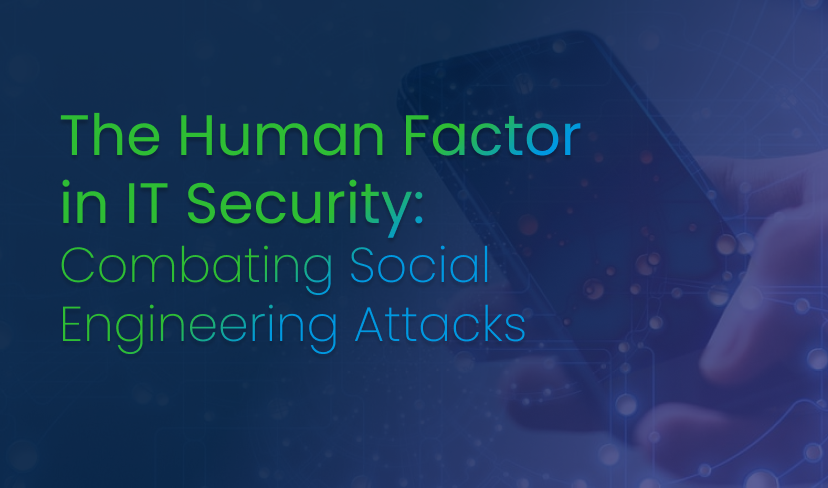As technology advances, so do the tactics of cybercriminals. One of the most pressing challenges faced by businesses today is the rise of social engineering attacks. These stealthy and cunning methods exploit human vulnerabilities, putting your valuable data and assets at risk. In this blog, we explore the power of cybersecurity as a service (CaaS), a proactive approach to fortifying your defences against social engineering. Discover practical strategies, real-life examples, and expert insights to safeguard your organisation. Let’s secure your digital environment and stay one step ahead of cyber adversaries. Your journey to enhanced cybersecurity starts now.
Understanding Social Engineering Attacks
What are Social Engineering Attacks?
Social engineering attacks (SEA) involve the exploitation of human psychology to deceive individuals into divulging sensitive information or performing actions that may compromise security. These attacks often leverage emotions such as fear, trust, or curiosity to manipulate targets. Some common types of social engineering attacks include:
Phishing Attacks
Phishing attacks are among the most prevalent SEA techniques. Cybercriminals send fraudulent emails masquerading as legitimate entities, enticing recipients to click on malicious links or provide sensitive information like login credentials or financial data.
Pretexting
In pretexting attacks, attackers create a fabricated scenario to manipulate individuals into sharing personal or confidential information. They may pose as a trustworthy individual or authority figures to gain the target’s trust.
Baiting
Baiting attacks entice targets with the promise of something enticing, such as free software or a downloadable file. However, the download contains malware that infects the target’s device.
Example: A USB drive labelled “Confidential Payroll Information” is intentionally left in a public area. An unsuspecting employee picks it up and plugs it into their work computer, unknowingly infecting the system with malware.
Tailgating
Tailgating involves an attacker physically following an authorised individual into a secure area. By exploiting the trust of employees, the attacker gains unauthorised access to restricted spaces.
Example: An impersonator waits outside a secure office building and follows an employee who uses their access card to enter. The impersonator pretends to be on a call and subtly slips in behind the employee, accessing the secure area without permission.
Examples of Social Engineering Techniques: The Trojan War
The Trojan War is a classic example of SEA dating back to ancient Greece. The Greeks cunningly used a wooden horse to infiltrate the city of Troy. They presented the horse as a gift to the Trojans, who, unaware of the concealed soldiers inside, brought the horse within the city walls. Under the cover of night, the Greek soldiers emerged from the horse, opening the gates for the Greek army to invade and conquer Troy.
The Role of Cybersecurity as a Service
How Can Cybersecurity as a Service Help Combat Social Engineering Attacks?
CaaS plays a crucial role in mitigating social engineering attacks and safeguarding businesses. Here’s how it can help:
Real-Time Threat Detection
CaaS offers real-time monitoring of network activity and user behaviour. This proactive approach enables the early detection of suspicious patterns or anomalies, helping to identify and block social engineering attacks before they cause harm.
Employee Training and Awareness
An essential aspect of CaaS is educating employees about social engineering techniques. Regular training sessions and awareness programs help employees recognise potential threats and adopt best practices to protect against attacks.
Incident Response and Recovery
In the event of a successful social engineering attack, CaaS provides swift incident response and recovery. This includes identifying the scope of the breach, containing the incident, and restoring affected systems to minimise the impact on the business.
Combating Social Engineering Attacks: Best Practices
Implementing Multi-Factor Authentication
Multi-factor authentication (MFA) is a powerful defence against social engineering attacks. By requiring users to provide multiple forms of identification, such as a password and a unique verification code sent to their mobile device, MFA significantly reduces the risk of unauthorised access.
Conducting Security Awareness Workshops
Regular security awareness workshops are instrumental in building a security-conscious culture within the organisation. These workshops equip employees with the knowledge and skills to identify and respond to social engineering attacks effectively.
Establishing a Robust Incident Response Plan
Having a well-defined incident response plan is critical to minimise the impact of a social engineering attack. The plan should outline the steps to be taken in the event of an incident, including communication protocols, containment measures, and recovery strategies.
Conclusion
The human factor remains a significant vulnerability in IT security, and social engineering attacks continue to pose significant risks to businesses. However, with cybersecurity as a service and proactive measures, organisations can strengthen their defences against these threats. By implementing best practices such as multi-factor authentication and conducting security awareness workshops, businesses can empower their employees to become vigilant defenders against social engineering attacks. Remember, protecting your business is a continuous effort, and Transputec is here to support you on your journey to secure and safeguard your digital assets. Contact Transputec today to get started with our expert cybersecurity services. Our team of professionals will work closely with you to develop a robust security strategy that suits your unique requirements.
FAQs
1. Can cybersecurity as a service prevent all social engineering attacks?
While cybersecurity as a service significantly reduces the risk of social engineering attacks, no solution can guarantee complete immunity. However, with continuous monitoring, proactive detection, and employee education, the likelihood of falling victim to such attacks is greatly diminished.
2. How often should employee training on social engineering be conducted?
Employee training on social engineering should be conducted regularly, at least once every quarter. Regular training ensures that employees remain vigilant and up-to-date with the latest tactics used by cybercriminals.
3. Can Transputec customise its cybersecurity services to suit my business’s specific needs?
Yes, Transputec understands that each business is unique, and cybersecurity requirements vary accordingly. We offer tailored solutions to meet your specific needs and challenges.
4. How quickly does cybersecurity as a service respond to incidents?
Cybersecurity as a service from Transputec emphasises prompt incident response. Our team is equipped to handle incidents swiftly, minimising the impact on your business and ensuring a rapid return to normal operations.







